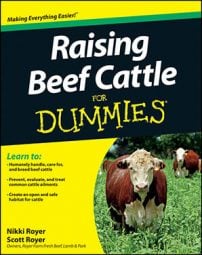When raising beef cattle, you want to start off on the right hoof by selecting healthy animals and by making their transition to their new home as smooth as possible. Consider these pointers when getting started on your bovine adventure:
Prepare your facilities before bringing home your first beef cattle. Your cattle need grazing areas with a good perimeter fence (either six-strand high-tensile or, at minimum, a 4-foot high woven wire), a strong pen or corral, a shelter, and clean loafing and eating areas.
Purchase only healthy animals. Your beef cattle should be alert without being wild. Their eyes should be bright, clear, and free of discharge. Their breathing should be smooth and regular, and they shouldn’t be coughing. The animal’s body should be full and rounded, not shrunken or hollowed out. They should be able to move with a free and easy stride.
Avoid buying cattle with mucus coming from the nose or that have swollen legs or joints. These symptoms may indicate illness or even an infection, which can be passed to other cattle and, in some cases, humans.
Prepare your trailer for hauling cattle. Clean the inside of the trailer to reduce the chance of disease transmission. Make sure it has a skid resistant floor to help keep cattle from slipping, and adjust the ventilation on the sides of the trailer so it’s appropriate for the weather conditions.
Load and unload the cattle in a quiet and patient manner. Being transported is stressful for cattle, but you can minimize their distress by being calm and taking your time. Although movie cowboys do a lot of whooping or hollering around their herds, such loud noises scare the animals and make them harder to load on the trailer the next time.
House your new arrivals in a small, secure holding lot and look them over for injuries. Limiting the size of the pen for your new cattle reduces nervous pacing and decreases the opportunity to escape. Make sure the pen is stocked with good-quality grass hay and plenty of clean water. After you unload all the cattle, check for any injuries that may have occurred during transport.
Keep your new cattle separate from the rest of your animals so they have no fence line contact. This quarantining procedure helps reduce the spread of disease through air, direct contact, feed, water, equipment, or traffic. Beef cattle may need to be isolated from 21 to 120 days depending on which diseases are of concern in your area. Your vet can help with specific recommendations.

